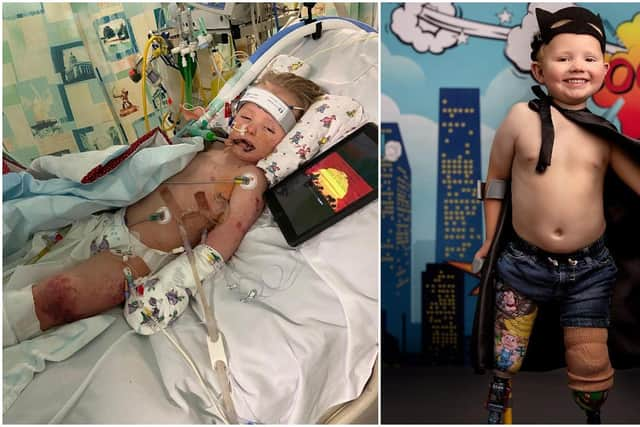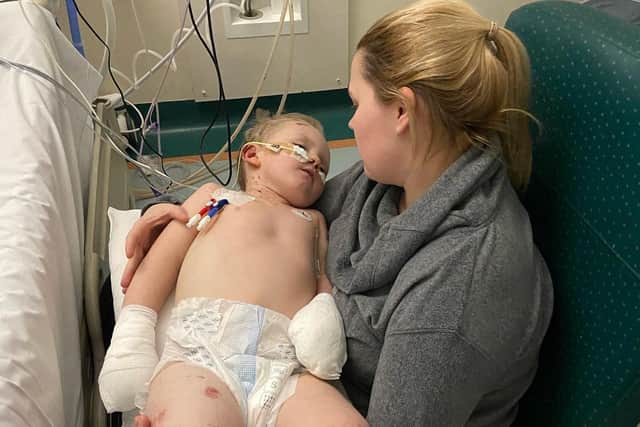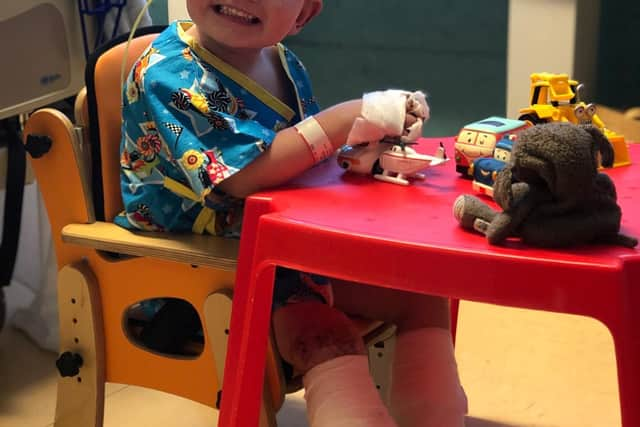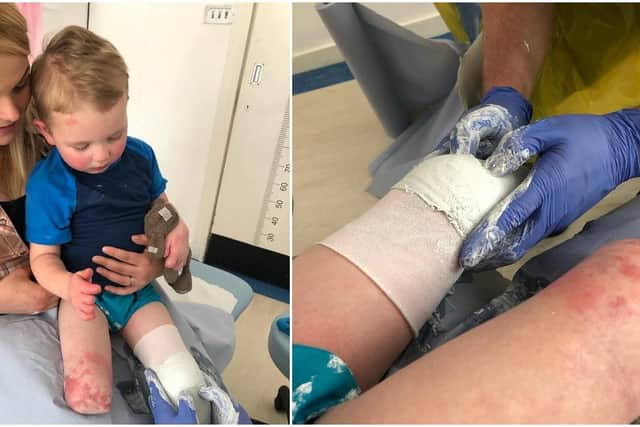Watch incredible moment miracle Huthwaite tot learns to walk again after losing legs to sepsis
This article contains affiliate links. We may earn a small commission on items purchased through this article, but that does not affect our editorial judgement.
and live on Freeview channel 276
When four-year-old William contracted sepsis in January, his family were told he wouldn’t make it through the night- seven months later, the miracle tot has defied the odds by learning to walk again after losing his legs to the deadly illness.
A shy-natured but happy little boy, William had up until this year enjoyed a clean bill of health and spent his days making mischief with little sister Georgia and his favourite toy ‘Stinky Ted’ at the family home in Huthwaite.
Advertisement
Hide AdAdvertisement
Hide AdBut one weekend, mum Gemma Reckless noticed something was off before William began displaying worrying symptoms such as a high temperature, vomiting and fatigue.
The following Monday, William was seen by a GP who put his symptoms down to ‘just a virus’- by Monday night William was in intensive care in an induced coma and his devastated parents were told to prepare for the worst.
It turned out the tot was suffering from scarlet fever which had rapidly developed into a life-threatening case of sepsis.
The next day, William’s little heart stopped beating and he was resuscitated as medics battled to save his life. But from then on, miraculously, he gradually began to improve.
Advertisement
Hide AdAdvertisement
Hide AdWhat followed was three months of ‘hell’ for the Reckless family as William took on complications such as a collapsed lung, a blood clot in his thigh and a brain injury resulting from lack of oxygen.


In March, surgeons worked ‘tirelessly’ to amputate William’s lower legs along with parts of his fingers- only his right thumb was left intact.
Less than 36 hours after the operation, the courageous youngster was sitting up in bed ‘munching mini eggs and watching Peter Rabbit’.
And just over a week later, he was finally allowed home.


Though the family is ‘through the darkest days’, William’s journey is far from over.
Advertisement
Hide AdAdvertisement
Hide AdNow Gemma, 30, is keen not only to praise ‘hero’ members of the NHS who saved her son’s life but also to raise awareness of sepsis before more families are affected.
"Not many people even know what sepsis is, despite the fact it kills more than breast, bowel and pancreatic cancer combined,” she said.
"As it is a response to an infection, people are also often under the impression sepsis only arises from a cut or a burn- not a condition like scarlet fever, which is normally mild.


"My message to any parents who are unsure is, please trust your instincts. Nobody knows your child like you do.
Advertisement
Hide AdAdvertisement
Hide Ad"Because William had beenhealthy up until that point, I was lucky in that I immediately picked up on the fact something wasn’t right.
"But with sepsis, it’s time-critical. There’s a ‘golden hour’ window that is the difference between being sent home with antibiotics and ending up in intensive care like William.
"After we came back from the GP, my husband Mike saw an article on scarlet fever doing the rounds again, and I’m so glad I dialled 111 and took William to hospital.
"I was told by A&E staff that he would have been dead within around four hours without treatment.
Advertisement
Hide AdAdvertisement
Hide Ad"Had we put him to bed that night, I dread to think what we would have found the next day. It haunts us.”


There is no reason why William will now not have a normal lifespan, though he has had to adapt to many challenges including learning to regain his speech which was lost due to his brain injury.
The family were dealt the added blow of not being able to receive visitors during lockdown, but say the community response has been phenomenal.
Relatives and friends rallied round to raise funds for a specialist TinyTrax wheelchair and well-wishers across the region have showered the brave youngster with gifts.
Advertisement
Hide AdAdvertisement
Hide AdLast week an online video showing William taking his first unaided steps wearing his prosthetic legs was viewed with awe by people all over the country, some of whom dubbed the brave boy ‘William the Conqueror’.
“When your baby takes their first steps, it’s magical and makes you so proud,” said Gemma.
“When they have to learn a second time- after months of watching their pain, fear, frustration, hard work and determination. The pride we feel is something else.”
But for every 20 second clip of of William ‘walking like the trooper he is’, there are hours of ‘physio, tears and tantrums’, added Gemma, who has documented her son’s journey on her Facebook page for business Little Gems which temporarily closed when William fell ill.
Advertisement
Hide AdAdvertisement
Hide Ad"The posts from hospital don’t show him screaming in pain and me trying to keep it together while the dressings were changed on his legs which were rotting away,” she said.
“I don’t ever want anyone to read my posts and feel like they need to be strong. Some days I neck Rescue Remedy like it’s going out of fashion, some days I sob on Mike and some days I need my mum for a hug.
“I never set out to share this journey I wish we never experienced, but the support and love from this community meant we gained a huge family of people invested in William, and for that I am thankful."
Dedicating a post to the NHS, she said: “We’ve always known we are lucky to have the NHS, but this year, what we have witnessed, has been something else.
Advertisement
Hide AdAdvertisement
Hide Ad“The morning William’s heart stopped we were taken to be with him, there were more doctors and nurses working on him than I could count. They were working second by second making difficult decisions that ultimately saved his life.
“They had that chance because the staff at our local hospital acted so quickly in stabilising him and getting him transferred. They had that chance because the 111 call handler listened to our concerns and gave us the right advice. Thank you to all of these people is simply not enough.”
You can still donate to the JustGiving page which has been set up by William’s friends and family and aims to raise £30,000 towards the youngster’s future here: https://www.justgiving.com/crowdfunding/letshelpwilliamwalkagain
Sepsis is the body’s extreme response to an infection. It is a life-threatening medical emergency.
Advertisement
Hide AdAdvertisement
Hide AdSepsis happens when an infection you already have —in your skin, lungs, urinary tract, or somewhere else—triggers a chain reaction throughout your body.
Without timely treatment, sepsis can rapidly lead to tissue damage, organ failure, and death.
Sepsis can be hard to spot, especially in children.
If your child is unwell with either a fever or very low temperature (or has had a fever in the last 24 hours), call 999 and just ask: ‘could it be sepsis?’
A child may have sepsis if he or she:
Is breathing very fast Has a ‘fit’ or convulsion Looks mottled, bluish, or pale Has a rash that does not fade when you press it Is very lethargic or difficult to wake Feels abnormally cold to touch
A child under 5 may have sepsis if he or she:
Is not feeding Is vomiting repeatedly Has not passed urine for 12 hours
For more information, visit:https://sepsistrust.org/